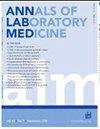Comparison of Two Quinupristin-dalfopristin Susceptibility Testing Methods and Two Interpretive Criteria for Enterococcus faecium Bloodstream Isolates from Korean Hospitals.
IF 3.9
2区 医学
Q1 MEDICAL LABORATORY TECHNOLOGY
引用次数: 0
Abstract
Enterococcus faecium, particularly in its multidrug-resistant forms, causes invasive nosocomial infections. Given the limited data comparing the effectiveness of the European Committee on Antimicrobial Susceptibility Testing (EUCAST) and the CLSI clinical breakpoints (CBPs) for quinupristin-dalfopristin (QD) resistance and the need to evaluate their practical application, we retrospectively investigated the susceptibility patterns of 287 E. faecium bloodstream isolates from Korean hospitals to QD using the updated EUCAST and CLSI CBPs and two antimicrobial susceptibility testing methods: disk diffusion (DD) and Sensititre broth microdilution (Sensititre). QD resistance rates were 5.9% (CLSI) and 18.8% (EUCAST) for DD and 22.6% (CLSI) and 28.2% (EUCAST) for Sensititre. The most prevalent QD resistance gene types among QD-resistant isolates were ermB+msrC+ or ermB-msrC+. Categorical agreement between DD and Sensititre ranged from 77.7% to 90.7%, depending on the testing method and CBPs applied. The EUCAST zone diameter CBPs more effectively help identify QD-resistant E. faecium isolates using the DD method than the CLSI zone diameter CBPs. In comparison, the CLSI minimum inhibitory concentration (MIC) CBPs provide more reliable results for resistance classification in the Sensititre method than EUCAST MIC CBPs. These findings would help improve clinical decision-making for treating multidrug-resistant E. faecium infections.国内医院两种奎奴普司汀-达福普司汀药敏试验方法及两种粪肠球菌血液分离株解释标准的比较
粪肠球菌,特别是其多重耐药形式,可引起侵袭性医院感染。考虑到比较欧洲抗菌药物敏感性试验委员会(EUCAST)和CLSI临床临界点(CBPs)对喹诺普司汀-达福普司汀(QD)耐药有效性的数据有限,以及评估其实际应用的必要性,我们使用更新的EUCAST和CLSI CBPs以及两种抗菌药敏试验方法回顾性调查了韩国医院287株粪肠杆菌血液分离株对QD的敏感性模式:光盘扩散法(DD)和敏度微稀释法(Sensititre)。DD的QD耐药率为5.9% (CLSI)和18.8% (EUCAST), Sensititre的耐药率为22.6% (CLSI)和28.2% (EUCAST)。QD耐药菌株中最常见的QD耐药基因类型为ermB+msrC+或ermB-msrC+。DD和Sensititre之间的分类一致性从77.7%到90.7%不等,这取决于所采用的测试方法和CBPs。EUCAST区直径CBPs比CLSI区直径CBPs更有效地帮助用DD方法鉴定耐qd的粪肠杆菌分离株。相比之下,CLSI最小抑制浓度(MIC) CBPs在敏度法中提供了比EUCAST MIC CBPs更可靠的耐药分类结果。这些发现将有助于改善治疗耐多药粪肠杆菌感染的临床决策。
本文章由计算机程序翻译,如有差异,请以英文原文为准。
求助全文
约1分钟内获得全文
求助全文
来源期刊

Annals of Laboratory Medicine
MEDICAL LABORATORY TECHNOLOGY-
CiteScore
8.30
自引率
12.20%
发文量
100
审稿时长
6-12 weeks
期刊介绍:
Annals of Laboratory Medicine is the official journal of Korean Society for Laboratory Medicine. The journal title has been recently changed from the Korean Journal of Laboratory Medicine (ISSN, 1598-6535) from the January issue of 2012. The JCR 2017 Impact factor of Ann Lab Med was 1.916.
 求助内容:
求助内容: 应助结果提醒方式:
应助结果提醒方式:


